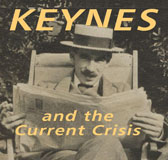Keynes: The “Revolutionary” Who Wasn’t
The General Theory and the Current Crisis: A Primer on Keynes’ Economics
Introduction: The “Revolutionary” Who Wasn’t
BY ALEJANDRO REUSS
This is a web-only article, available only at www.dollarsandsense.org.

Keynes is often described as a “revolutionary” thinker. In one sense, this is correct. Keynes was one of the most important economic thinkers of modern times, and his ideas were at the center of a major “paradigm shift” in economic theory and policy. He issued his masterwork, The General Theory of Employment, Interest, and Money(1936), at a critical juncture, in the middle of the Great Depression, when the orthodox views from which he had broken seemed at a loss to explain the crisis or a way out of it.
Keynes was not the first major economic theorist to understand that capitalist economies were prone to depressions (Marx had written on the subject nearly a century before), nor was he the only major economist of his generation to arrive at the basic insight that total demand could fall short of the level required to ensure full employment. (Some others, most notably the Polish economist Michal Kalecki, came to the same conclusions separately from, and even slightly earlier than, Keynes.) Keynes, however, was already a major figure in British economics and politics at a time when Britain was a much more important world power than today, so his ideas had a bigger impact in ruling circles than they would have coming from elsewhere, or from economists with a more radical views about the changes necessary to cure the problem.
As “revolutionary” a figure as Keynes was in the history of economic thought, he was, in another sense, a profoundly anti-revolutionary thinker. This is not to say that the changes he proposed, particularly in the role of government in capitalist economies, were trivial. He believed the problems of capitalism—especially the “arbitrary and inequitable” distribution of income and wealth and the “failure to provide full employment”—were very serious, and he did not think that these “outstanding faults” of capitalist economies would fix themselves. He thought that the state would have to play a major role in fixing them. However, as much as it was his goal to get rid of what he considered bad about capitalist societies, he also aimed to preserve what he considered good about them, which was a great deal.
In The General Theory, Keynes praises in no uncertain terms what he considers the virtues of “self-interest,” “individualism,” and “private initiative and responsibility” and their place in a capitalist society. His motive for wanting to eliminate excessive inequality and unemployment was, to a great extent, that he viewed them as threats to capitalism. In his view, these “outstanding faults” created the danger of revolutionary upheaval. An enlargement of the role of government was the “only practicable means” for eliminating these problems and “avoiding the destruction of existing economic forms in their entirety.” It is easy to imagine Keynes lashing those who denounce government intervention in the economy as “socialism” for their failure to recognize these policies as means of preserving a well-functioning capitalist economy.
The “Socialization of Investment”
Keynes did not object to “significant inequalities” in income and wealth, and therefore did not aim to create a society in which incomes and wealth were equally (or almost equally) distributed among all members of society. He offered two justifications for inequality, as an incentive for productive activity and as a channel for competitive impulses that otherwise, he thought, might take on more predatory forms. However, he did think that existing inequalities were excessive, and that it would be desirable to reduce them.
Keynes did not believe that the accumulation of saving in the hands of the wealthy—and the necessity of this saving for financing investment—justified inequality. He pointed out that the rates of interest necessary to pry away the savings of the rich for use by society to finance investment were typically too high to be consistent with full employment. With interest rates too high, Keynes argued, investment is too low (since some investment projects that would be profitable at a lower rate of interest would not be profitable, and therefore would not be undertaken, at a higher rate), and therefore so are total output and employment.
Keynes viewed income from interest (which he called “rentier” income) as basically parasitic. He compared the interest income of the “functionless investor” to the rental income of landlords. Neither interest nor rent, he argued, required any “genuine sacrifice” on the part of their recipients. Rather, they were merely rewards for owning scarce resources. He advocated, therefore, a reduction of the interest rate to little or nothing and what he termed the “euthanasia of the rentier.” The cost of capital equipment, he argued, would cover its production cost, as well as allowances for depreciation and risk, but not incomes for idle owners of capital.
Keynes did not think that the dramatic reduction of interest rates need disrupt the functioning of a capitalist economy. First, he recognized that such a policy would increase the incentive to spend on present consumption. He did not agree with conventional economists, however, that this would necessarily reduce overall saving or investment. He argued that increased consumption expenditures, by increasing demand and resulting in higher incomes, could actually increase saving and investment. Second, he argued that higher interest rates resulted in lower investment, since entrepreneurs would only engage in investment projects that produced returns at least equal to the rate of interest. Therefore, lower interest rates, not higher, would result in higher investment and incomes. Third, Keynes argued that a major government-directed investment program could eliminate the scarcity of capital and, with it, the “oppressive power of the capitalist” to extract a tribute in the form of interest.
Keynes proposed that “communal saving through the agency of the State” take the place of private saving in financing investment. The details in The General Theory are rather sketchy, but one can imagine a government investment fund that either supplies private businesses with funds to finance the purchase of durable equipment or that finances the construction of such equipment directly and rents it out to private businesses. Keynes does not go into detail on the sources of this saving, though he seems to be thinking primarily of tax revenue (rather than voluntary deposits in a public bank). While he mentions “higher taxation of larger incomes and inheritances” as one possibility, he does not come down firmly in favor of this idea. Nor does he come to any firm conclusions about the magnitude of such savings—the degree to which it is “right and reasonable to call on the living generation to restrict their consumption” for the benefit of future generations.
What Keynes Did Not Have in Mind
Keynes did not favor the general socialization (public control) of productive enterprise. He regarded private enterprise as a source of “efficiency” and a “safeguard of personal liberty” (379-381). He envisioned the state as regulating the overall levels of consumption and investment, an enlarged role to be sure, but one perfectly consistent with leaving most of the economy in the hands of private actors. This overall regulation could be accomplished, he argued, by such means as control of taxes and interest rates, and did not require the “ownership of the instruments of production” by the state (378-379).
Keynes did not favor the elimination of all inequality of income or wealth, which he viewed as incentives for “valuable human activities,” nor the elimination of all income from property. While Keynes criticized the landlord and rentier as parasitic, he certainly did not view business owners in this way. (When he referred to the “oppressive power of the capitalist” to exploit the scarcity of capital, he was reserving the term “capitalist” for the rentier. He usually used the term “entrepreneur,” rather than “capitalist,” for business owners.) Keynes suggested that the elimination of interest income—from “risk-free” investments—would still leave room for investor to profit from the exercise of “enterprise and skill” in choosing among risky investments (221). He also thought that society could benefit from the “intelligence and determination and executive skill” of business people, which could be “harnessed … on reasonable terms of reward” (376-377) under a system of progressive taxation.
Keynes did not aim at a major upheaval in the basic economic or political institutions of capitalist societies. He did not oppose private property (over productive resources such as factories, mines, land, etc.), wage labor (workers being hired for pay by the owners of these resources), or market exchange. Nor did he favor sudden or conflictive social change. Quite the contrary, Keynes clearly describes himself as an enemy of revolution and insists that none of the changes that he proposes require one. He imagines the “euthanasia of the rentier” as a quiet and incremental process, “nothing sudden, merely a gradual but prolonged continuance of what we have seen recently in Great Britain, requiring no revolution” (376). The overall government regulation of economic activity, he argues, could be “introduced gradually and without a break in the general traditions of society” (378).
What Keynes Did Have in Mind
The picture that emerges, Keynes as an advocate of a “regulated capitalism,” with a substantially increased role for the state in economic life (especially in guaranteeing full employment) and reduced inequality of incomes and wealth, is correct but incomplete. A fuller picture of Keynes’ social vision comes from his political writings of the 1920s, especially a 1926 book titled Britain’s Industrial Future. While formally issued by an economic commission of Britain’s Liberal Party, Keynes authored several sections outlining his view of the place of the large corporation in Britain’s present and future.
Keynes’ views of the large corporation strongly paralleled those of a school of thought known as “managerialism.” (The Modern Corporation and Private Property (1932), by U.S. economists Adolf Berle and Gardiner C. Means, is usually regarded as the founding statement of managerialism. Keynes, however, actually anticipated its main conclusions by several years.) Managerialists argued that most large corporations were controlled by paid managers (top executives and directors) rather than by individual owners or shareholders collectively. The ownership of shares in a typical large corporation, they argued, were dispersed among such a large number of shareholders that it was not typically possible for most of them to have much knowledge of or say in the corporation’s day-to-day decisions. Managerialists concluded that this gave managers a high—some argued, nearly total—discretion in how to run those companies, effectively disenfranchising the stockholders (their titular “owners”).
In Britain’s Industrial Future, Keynes argued, much as the U.S. managerialists would, that many corporations had “passed out of the effective control of their shareholders.” Keynes argued that “shareholders are so scattered and disorganized that it is seldom or never practicable” for them to control the composition of the management. As a result, in “large companies of diffused ownership,” he argues, directorships come to resemble “offices for life.” Keynes did not think that the insulation of management from control by the stockholders was necessarily a good thing. Directors, he argued, could be “useless” and “without special qualifications,” or command “high [pay] relative to the work done,” and still keep their positions. Stockholders’ lack of information about the inner workings of a company could also permit directors to “take great advantage over other shareholders through their knowledge of the exact position of their concern” (that is, to take advantage of insider information).
Like the U.S. managerialists, however, Keynes hoped and believed that the “separation between ownership and management” might liberate managers from the tyranny of the bottom line, and allow them to pursue other (hopefully, socially laudable) aims. In his essay “The End of Laissez-Faire” (1926), Keynes suggests that large corporations may, under some circumstances, act with the social welfare, rather than private gain, in mind. As management grew increasingly independent from ownership, Keynes argued, it tended to focus on the “general stability and reputation of the institution” instead of the maximization of shareholder profits. Corporations, in his view, were becoming more and more like quasi-public institutions “whose criterion of action within their own field is solely the public good as they understand it, and from whose deliberations motives of private advantage are excluded.” More concerned with their public image than the bottom line, large private corporations, such as railroads, utilities, universities, banks, insurance companies, Keynes argued, were “as time goes on, socializing themselves.”
Keynes, Technocracy, and Democracy
This argument reflects the strong technocratic streak in Keynes’ thought. Keynes thought that the world should be governed by an educated elite that, in his view, would stand above conflicting class interests and govern in the public interest. He did not believe that political, intellectual, or economic elites always acted in the best interests of society as a whole, but he did believe that the right elites could. Moreover, he certainly did not believe that ordinary people could run society well, or should run it at all.
In The General Theory, Keynes frames his argument against “State Socialism”—that is, against the comprehensive nationalization of the “instruments of production”—as a caution against the “homogeneous or totalitarian state.” Too much nationalization, he seems to suggest, and you’re in Stalinist Russia (or Nazi Germany or Fascist Italy). His argument against a socialism that would lift the working class to power is different. Keynes famously wrote, in a rant against Marxism in the essay “A Short View of Russia” (1925): “How can I adopt a creed which, preferring the mud to the fish, exalts the boorish proletariat above the bourgeois and the intelligentsia who, whatever their faults, are the quality in life and surely carry the seeds of all human advancement?” That is not an argument against totalitarianism, but against democracy.
Keynes’ certainly had no sympathy for the radically democratic ideas, advocated by some socialists in his day and ours, that the principles of self-government should not end at the door to the workplace, and that no real democracy can exist in the political sphere as long as the economic sphere is dominated by unelected captains of industry (whether owners or managers). Keynes undoubtedly would have cringed at the idea of allowing the “boorish proletariat” to decide how a factory should be run, much less an entire economy. If ordinary people were allowed to decide the fate of society, Keynes believed, their ignorance and lack of refinement would stand in the way of “human advancement.”
Keynes’ outlook was consistent with political democracy, in the sense of a multiparty system with competitive elections, but not with a very participatory version of it. He was even suspicious of labor-based political parties that—unlike the elite that he imagined standing above all class interests—he denounced as “class” parties. As biographer Robert Skidelsky notes, Keynes believed society could be ruled by an “interconnected elite of business managers, bankers, civil servants, economists and scientists, all trained at Oxford and Cambridge and imbued with a public service ethic.” In other words, he thought it should be ruled by people rather suspiciously like him.
Alejandro Reuss is an historian and economist, and a member of the Dollars & Sense collective.
Did you find this article useful? Please consider supporting our work by donating or subscribing.





